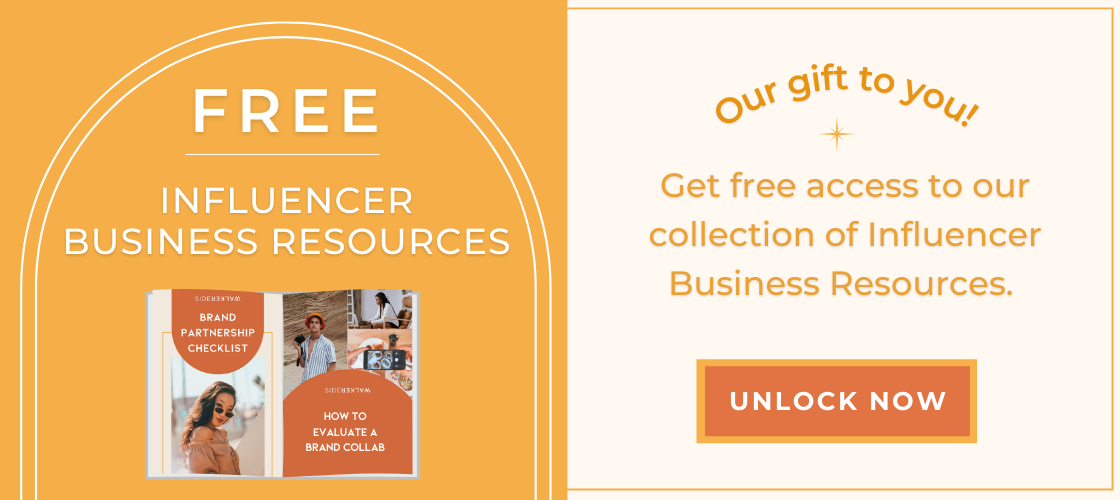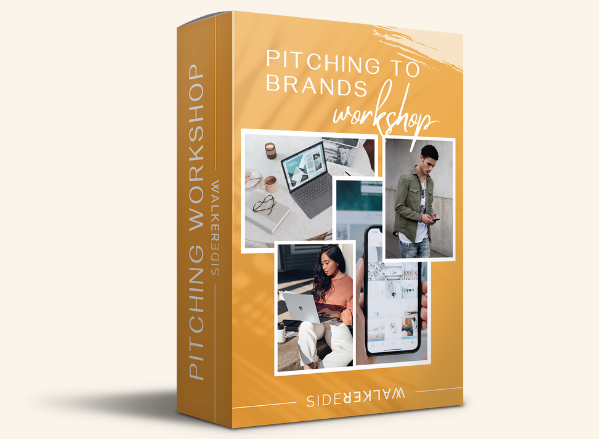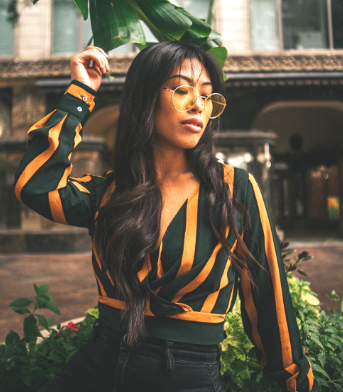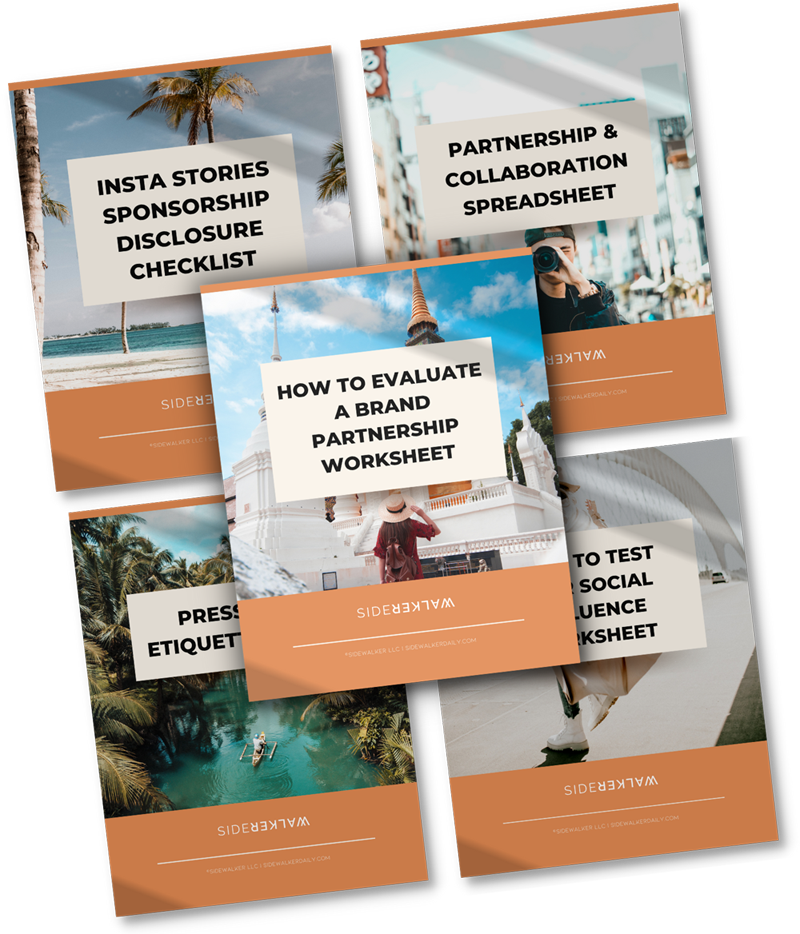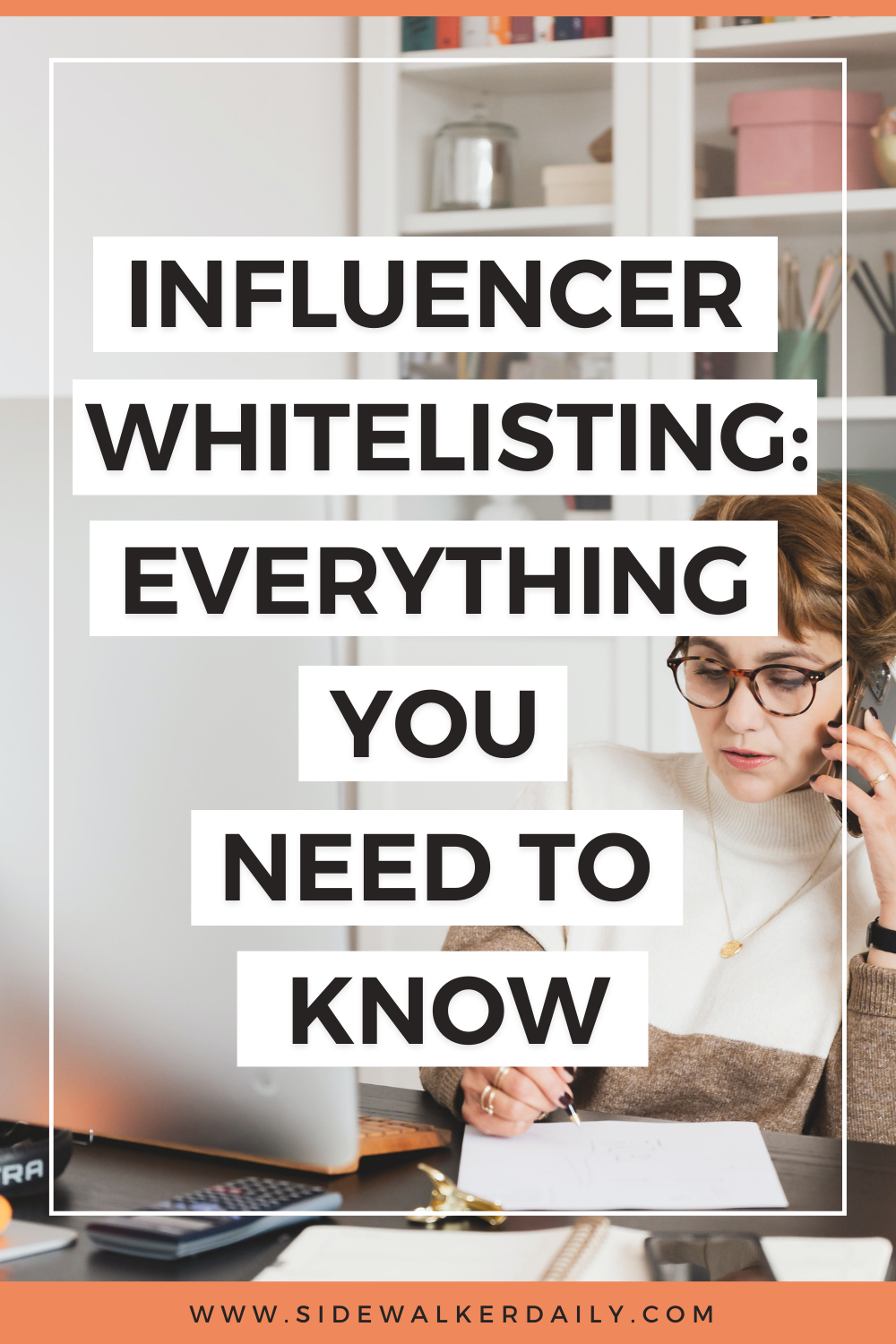
Influencer Whitelisting: Everything You Need To Know
The Influencer and social media industry is constantly changing. New strategies and terms keep popping up as the space evolves, a recent one being Influencer whitelisting. If you’re an Influencer or Creator who works with brands, you’ve probably had a brand ask you about whitelisting your content. Even if you haven’t been asked about whitelisting just yet, it’s likely to be a situation you’ll have to face in the near future.
Here at Sidewalker Daily we help Influencers and Creators land brand partnerships and build sustainable businesses. We also work with brands and companies on developing their Influencer marketing campaigns, so we have a unique perspective that we share with our community of Creators.
Since we started in this industry in 2015, there have been so many changes – one of the biggest being brands’ acceptance of using Influencer marketing as part of their overall marketing strategy. Brands are always working on getting the most out of their marketing initiatives: they’re in the business of making money and seeing results. So of course, a lot of emphasis is placed on the ROI of any marketing initiative and this is no different when it comes to Influencer marketing.
With Influencer marketing however, brands are a little less involved in the creation of the content. Influencer whitelisting has entered the picture as a way for companies to keep using the power of Influencer marketing, while having some control and insights into the results.
In this article, we’re discussing some key takeaways about Influencer whitelisting and what you need to know if a brand wants to include this in your partnership agreement. Outside of knowing what Influencer whitelisting is, you’ll want to know things like how to whitelist on Instagram, how much to charge for whitelisting, and how it affects your account and your content. Let’s dive in!
What Is Influencer Whitelisting?
Influencer whitelisting is when a brand gets the permission from an Influencer to run paid ads through the Influencer’s social media account and identity. Although the ad will be displayed from the Influencer’s account, the ad can be created in the brand’s ad account, which gives them complete control.
Influencer whitelisting can also be a situation where a brand requests permission from the Influencer to use their likeness in advertisements. So instead of a brand running a paid ad for a post that talks about their product or service, they will leverage the goodwill and likeness of the Influencer to speak about the brand’s products or services on their behalf.
Most commonly, Influencer whitelisting is a part of the deal a brand makes with an Influencer who is doing a sponsored post or paid campaign for the company, as it can be very beneficial to them. Essentially, they are paying for the Influencer to create the advertisement through a traditional paid partnership and for the ability to put paid advertising spend behind it to amplify its reach. It’s like a two for one, especially since the brand can choose which audience to target with the ad.
We all have felt the pain of unpredictable social media algorithms at one time or another. Brands have to consider this when they pay a lot of money for Influencers to create and post content. Sometimes the organic post doesn’t reach the amount of people they hoped, which can be really disappointing for the company. With Influencer whitelisting, brands are able to keep using the Influencer’s posts to reach more people beyond the influencer’s organic following on social media.
In summary, whitelisting allows a brand to reuse the Influencer’s creative, but control its reach by running different ads, targeting different audiences, and shifting the messaging if needed.
Influencer Dark Posts vs Influencer Whitelisting
Another term that you might hear alongside Influencer whitelisting is dark posting. Knowing the difference is really important when a brand brings it up in a partnership discussion, so let’s go over dark posting vs whitelisting.
Influencer dark posts are Facebook and Instagram ads that are published on behalf of an Influencer, but they do not show up on that Influencer’s own social media feed. This means that only people who are specifically targeted through paid ads will see them. They do not show up publicly on an Influencer’s account and they do not show up on the feed or timeline of anyone who is following the Influencer.
Why might you, as an Influencer (or the brand) want to do dark posting? While dark posts are still able to be controlled by the brand, they don’t require the Influencer to fill their feed or overcrowd their followers with ad posts. A brand can request additional creatives as part of the brand partnership to use as dark posts, and the influencer won’t have to post them to their own account. Only certain people who are targeted by the brand will see the ad- and even if they choose to click through to the Influencer’s profile, the post won’t be found there.
How Does Influencer Whitelisting Work?
The most typical scenario for Influencer whitelisting on Instagram or Facebook is when a brand and Influencer are working together on a brand partnership. For the brand partnership, the Influencer creates content to post on their social media accounts, promoting the brand’s product or service.
As part of the contract negotiation for the paid partnership, the brand might request the option to whitelist what the Influencer creates. If the brand does ultimately decide to whitelist, they would request access to the Influencer’s account. This access would allow them to use the Influencer’s handle, content, and audience to run paid social media campaigns.
On the Influencer’s side, they would have to give the brand access in one of two ways. They would either grant access manually or go through a third party platform specified by the brand. Some brands use third party platforms to manage their Influencer whitelisting initiatives for them. Another thing to know about whitelisting with Instagram is that there are some requirements for the Influencer to even do it. Although these requirements will likely change over time, currently an influencer has to have a business profile, creator account, or a verified Instagram account.
After a brand gets access to the Influencer’s account, they are able to run advertisements through the Influencer’s handle. So for viewers, it will seem as if the Influencer is promoting the post (as opposed to it coming from the brand).
One of the most frequent questions we get from our Influencer clients about Influencer whitelisting is, “What can the brand control?”
When the brand runs an ad through an Influencer’s account they can control:
- The Creative: The image, video, or set of images that will appear in the ad
- The Copy: The caption or messaging, which would be what the Influencer is saying since it’s coming from their account
- Call to Action or Headlines
- Which audience the post is promoted to on social media
- Budget behind the advertising spend
- Length of time the ad will run
The brand has a lot of control over what’s going to be in the ad. While this is great for the brand, the Influencer should know and approve important aspects of the ad before it goes live. Later in this post we will go into more detail about what you, as an Influencer, should consider about the brand’s control.
Why Do Brands Engage In Whitelisting?
Over time, the decline in organic reach on social media has been a concern for brands engaging in Influencer marketing. Since organic reach depends on the social media platform’s algorithm, and that algorithm changes frequently, it can affect the overall reach of the content. This in turn limits the amount of people who see the messaging and learn about the product or service.
That’s a big reason why Influencer whitelisting is exciting for brands. It allows them to amplify their Influencer-created content and reach a targeted audience on social media beyond those who follow the Influencer. They can reach their target customer and scale that reach based on how much money they want to put behind the ad.
Not only do they get more reach out of the posts, more of that reach goes to a specific type of customer. Consider an Influencer’s organic post. This post reaches only the Influencer’s organic audience…which probably includes some followers who aren’t the brand’s ideal customer. With the ability to run paid ads using that same content, a brand can ensure that the money spent reaches an audience that they specifically want to target.
Let’s just say for example you want to promote your online beauty supply store and you only sell and ship in the US. You approach an Influencer and they want to charge you $5,000 to do a post on their Instagram account and that post will reach their audience of beauty product enthusiasts. Their audience is made up of people from 60% United States, 20% England, 10% India, and 10% other. That means with a budget of $5,000, you would reach 60% of their US based audience which are your target customers and who can actually buy from you. By running paid ads, that $5,000 could be put towards social media ads and you would be able to control that the content is seen by only people in the US. So that means 100% of the people seeing the ad would be your target customer vs the 60% of the influencer’s organic audience.
Another reason brands do influencer whitelisting is because they can specifically target potential customers such as website viewers, sales page visitors, and shoppers who abandoned their carts. Showing these people an Influencer’s post might be the push they need to complete their sale. Instead of sending them an advertisement from the brand’s account, they see an Influencer’s testament to the product or service. This may help convince them of the decision to revisit your website or complete a sale.
Influencer whitelisting is also beneficial for brands because they can run targeted ads using messaging from an Influencer’s account. Advertisements are much more relatable coming from someone other than the brand themselves, which increases the probability of the conversion. An Influencer can talk about the brand, product, or service in a way that the brand can’t, giving some social proof to what the brand offers.
No one likes to be sold to; it’s much more interesting to hear why someone else likes a product or service. This method is basically a roundabout way to achieve word of mouth advertising. As of yet, there is no disclaimer required to say that an ad is from the brand’s account vs the Influencer’s account. And since many people on social media cannot tell the difference between an Influencer boosting a post and a brand running an advertisement through the Influencer’s handle, the ad seems more natural.
In the beginning of the Influencer brand partnership days, it was really hard for brands to track metrics and truly evaluate performance. This is yet another thing that Influencer whitelisting helps with since it gives brands the ability to measure the ROI of their Influencer initiatives quickly and easily. With direct control of the ad, they are able to see real time metrics and analyze the performance of the Influencer’s content in a way they never have been able to before.
Finally, brands engage with Influencer whitelisting because they are able to run ads through the accounts of multiple Influencers at the same time. This generates a lot of buzz around a product or service that can be extremely beneficial. Imagine you’re someone who loves following a handful of travel Influencer accounts. One week, you see 7 of these travel influencers talk about a new travel app. You probably wouldn’t be able to resist checking it out! It’s just human nature to want to be in on what everyone’s talking about and these paid ads can create that buzz on social media.
All in all, adding Influencer whitelisting to a brand partnership leads to Influencer campaigns with advertising options far beyond the traditional partnership. Brands are able to invest in organic reach and put paid advertising spend behind an Influencer’s account. The ad has a voice that is more relatable and coming from someone other than the actual brand, strengthening the message and likelihood of success.
What An Influencer Should Consider If A Brand Wants To Engage In Influencer Whitelisting
You now know how an Influencer Whitelisting campaign works, but thinking about giving a brand access to your account as Influencer might still seem like a lot. Allowing anyone to control a part of your business- literally running ads on your behalf- is a big decision, so you need to trust the brand partner and feel confident that they are going to be transparent throughout the whole process. Granting this access comes down to trust, but we’re going to give you some tips so you can feel more confident moving forward.
But before we do, you need to remember that your reputation and relationship with your audience (and potential audience) is one of the most valuable assets to your Influencer empire. Once you give the brand access, you have little control over the ads, so it’s important that everything is set out clearly in a contract beforehand.
So what are some things you should ask?
1. The Approval Process
Ask the brand how much involvement you’ll have in the approval process. Basically, will you be allowed to approve or ask for changes before the ad gets published? Ask the brand if there is an approval process for edits and changes they make to your content. Some brands may want to edit your captions, add a discount code to promote a sale, or even use a holiday caption if there is an upcoming holiday campaign. After all, they are speaking on your behalf so you want to make sure that what they say is approved by you first!
2. The Intended Target Audience
Another good thing to ask about is the audience they plan to target. Your current audience might love your content, but if they choose (on purpose or by mistake) an audience that might not you might run into a PR nightmare you need to handle. Unfortunately, social media is divided on many topics, so this is something to keep in mind. If the brand is pushing your content out to a certain audience, it should be a good fit for your personal brand too.
3. The Length of the Campaign
You should make sure you have a clear understanding of not only how long the brand wants to whitelist your content for, but how long they will have access to your account. Further, know what permissions they have when they access your account and everything they are able to do. What does their process look like for losing access to your account once they stop running paid ads? You don’t want them to have access forever.
All of these things should be discussed (and laid out in a contract) before you allow a brand to run paid ads on your behalf. Always remember, you are a business owner and are allowed to negotiate terms and demand clear expectations. The contract plays an important role in this, protecting you and your business. For a successful partnership, it is in both parties’ interests to make sure everything is in the contract and the terms are clear and match what you agreed to do. Many brands are sneaking whitelisting clauses into contracts as standard language, so it’s important to look out for it, even if it wasn’t in your discussions with the brand beforehand.
Dealing with contracts can be overwhelming since they are very detailed and typically drafted by a brand’s lawyers. Even so, it’s important to remember that dealing with contracts is something all business owners have to do. If you need help understanding your Influencer contracts and negotiating with brands, our Influencer Contracts course breaks down the need-to-know terms into simple language so that you can feel confident when it comes to negotiating and signing contracts for your brand partnerships.
What To Charge A Brand
The question we get asked the most by our clients is how much to charge for whitelisting. Just like figuring out rates for brand partnerships, you will have to consider how you will charge brands for whitelisting your content. Determining your rates can be done in a multitude of ways – there is no one right way as it all depends on certain factors. Actually, some Influencers don’t charge at all for whitelisting, because they find value in the amplification of their content by the brand to reach more people. Alternatively, there are others who would never let a brand run paid ads with their content without getting compensation.
In our Pitching To Brands Mastercourse, we teach you how to come up with your rates and go over all of the Fundamental Rate Factors you need to consider, including Influencer Whitelisting. If you’re an influencer or creator who is looking to land paid brand deals and understand how to create a media kit, case study and figure out your rates to charge brands, then our Pitching To Brands Mastercourse has everything you need to be confident when pitching and working with brands.
Now, you have a good understanding of what exactly whitelisting is and how you should approach it when a brand does ask. Remember, always make sure you have open communication with a brand that you’re allowing to use your content in their own advertising initiatives.
So to summarize, what you need to know about Influencer whitelisting is:
1. Influencer whitelisting is when a brand asks an Influencer to run paid ads through the Influencer’s social account instead of their own.
2. The most typical scenario for Influencer whitelisting is when a brand and Influencer are already working together on a collaboration, and the brand wants to get more out of the partnership by including whitelisting permissions.
3. With whitelisting, the brand runs paid ads using a post made on the Influencer’s account. Dark posting, on the other hand, allows a brand to run paid ads using the Influencer’s name, but the posts don’t actually show up on the Influencer’s own account.
4. Brands engage in Influencer whitelisting because it allows them to have more control over the ad, insights and results.
5. When an Influencer gives a brand permission to whitelist their content, they must understand that the brand has the ability to control the ad’s copy, imagery, target audience, and the ad’s budget and length.
6. As an Influencer, your accounts and your brand are an important part of your business so it’s important to make sure that there is an approval process in which you can give your approval to a brand before they run an ad and be informed of the details of the ad.
And last but not least, don’t hesitate to reach out to a professional influencer coach for help if you’re struggling in your business, feel stuck or have questions that you want clear and straightforward answers to. By working with one of us, we can answer the specific questions you have for your business and come up with a tailored game plan to help you find success. To work with us in a private coaching session, all you have to do is click here.
If you found this article helpful, we’d love to hear your thoughts in the comments below!


